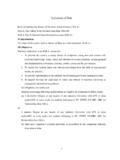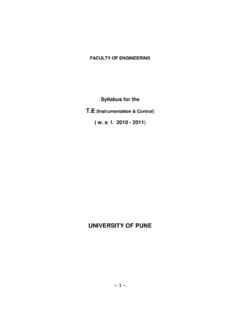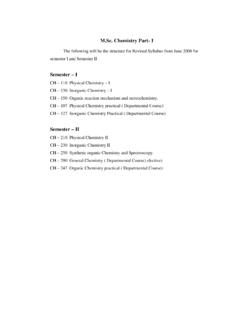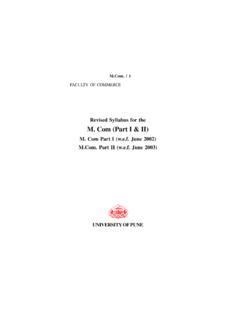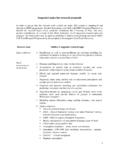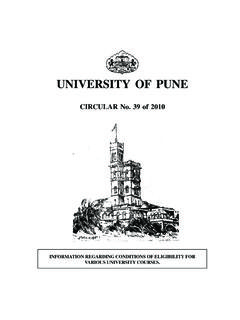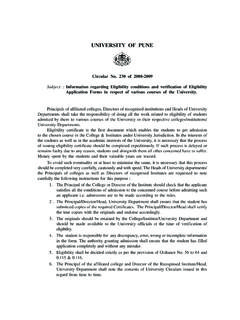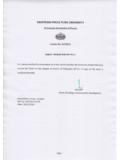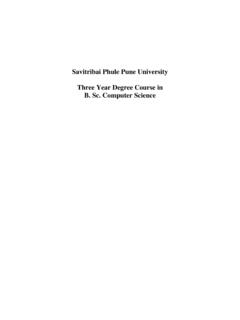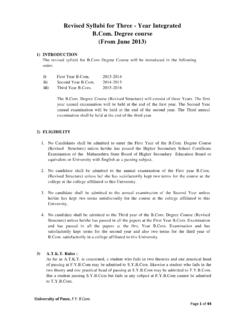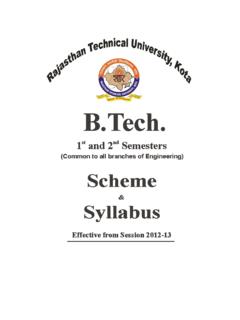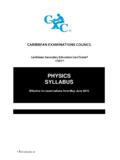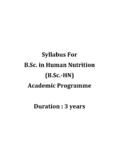Transcription of PART – II
1 University of Pune Faculty of Engineering (Common to All Branches) 2008 Structure ( June-2008) PART I CODE SUBJECT teaching SCHEME examination SCHEME Lect. Tut. Drg. Paper TW Oral Pr Total 107001 Engineering Mathematics-I 4 - - 100 - - - 100 107002 Applied Science I 4 - 2 100 25 - - 125 110003 Fundamentals of Programming languages. 1 - 2 - - - 50** 050 103004 Basic Electrical Engineering 3 - 2 100 25 - - 125 101005 Basic Civil and Environmental Engineering 3 - 2 100 25 - - 125 102006 Engineering Graphics I 3 - 2 100 - - - 100 111007 Manufacturing Practices - - 2 - 25 - - 025 Total of Part I 18 - 12 500 150 - - 650 PART II CODE SUBJECT teaching SCHEME examination SCHEME Lect. Tut. Drg. Paper TW Oral Pr Total 107008 Engineering Mathematics-II 4 - - 100 - - - 100 107009 Applied Science II 4 - 2 100 25 - - 125 101010 Engineering Mechanics 3 - 2 100 25 - - 125 104011 Basic Electronics Engineering 3 - 2 100 25 - - 125 102012 Engineering Graphics II 1 - 2 - 50 - - 050 102013 Basic Mechanical Engineering 3 - 2 100 25 - - 125 Communication Skill * - - 2 - - - - - Total of Part II 18 - 12 500 150 - - 650 * Communication Skill : Practical will be conducted by respective departments.
2 Hence no subject code is ** This change has been done in the Meeting of Dean & Chairman of Faculty of Engineering held on dt. 23-5-2008. UNIVERSITY OF PUNE syllabus for Engineering Degree Course Revision 2008 Semester I: 107001 Engineering Mathematics I teaching Scheme: examination Scheme: Lectures 4 Paper 100 Marks\(3 Hrs. Duration) Unit 1 (09 Hrs.) Matrices: Rank, Normal form, System of Linear Equations, Linear Dependence and Independence, Linear and Orthogonal Transformations. Eigen values, Eigen Vectors, Cayley Hamilton Theorem. Application to problems in Engineering (Translation and Rotation of Matrix). Unit 2 (09 Hrs.) Complex Numbers & Applications: Argand s Diagram, De'Moivre's theorem and its application to find roots of algebraic equations.
3 Hyperbolic Functions, Inverse Hyperbolic Functions, Logarithm of Complex Numbers, Separation into Real and Imaginary parts, Application to problems in Engineering. Unit 3 (09 Hrs.) Infinite Series: Infinite Sequences, Infinite Series, Alternating Series, Tests for Convergence, Absolute and Conditional Convergence, Range of Convergence. Differential Calculus: Successive Differentiation, Leibnitz Theorem. Unit 4 (09 Hrs.) Expansion of Functions: Taylor's Series and Maclaurin's Series. Differential Calculus: Indeterminate Forms, L' Hospital's Rule, Evaluation of Limits. Unit 5 (09 Hrs.) Partial Differentiation and Applications: Partial Derivatives, Euler's Theorem on Homogeneous Functions, Implicit functions, Total Derivatives, Change of Independent Variables.
4 Unit 6 (09 Hrs.) Jacobian: Jacobians and their applications. Errors and Approximations. Maxima and Minima: Maxima and Minima of Functions of two variables, Lagrange's method of undetermined multipliers. Text Books: Higher Engineering Mathematics by Ramana (Tata McGraw-Hill). Advanced Engineering Mathematics by Erwin Kreyszig (Wiley Eastern Ltd.). Reference Books: Advanced Engineering Mathematics, 7e, by Peter V. O'Neil (Thomson Learning). Advanced Engineering Mathematics, 2e, by M. D. Greenberg (Pearson Education). Higher Engineering Mathematics by B. S. Grewal (Khanna Publication, Delhi). Applied Mathematics (Volumes I and II) by P. N. Wartikar & J. N. Wartikar (Pune Vidyarthi Griha Prakashan, Pune). UNIVERSITY OF PUNE syllabus for Engineering Degree Course-Revision 2008 Semester I : 107002 Applied Science I teaching scheme: examination scheme: Lectures 4 Paper 100 Marks(3 Hrs) Practicals- 25 Marks Both schemes are exactly half for Chemistry and Physics each Chemistry Unit 1 : Solid state and materials chemistry (08 Hrs.)
5 Crystallography:- Unit cell, Bravais lattices, Cubic crystals - CN, APF, radius ratio. Three laws of crystallography, Weiss indices and Miller indices with numericals, X-ray diffraction Bragg s Law and numericals. Crystal defects (point and line defects) and their effects on properties of crystals. Zinc sulphide structure and applications as luminescent. Molecular electronics:-Basic concepts. Study of following molecules for their structures and properties on the basis of orbitals, chemical bonding, band theory, electrical conductivity, applications in electronics such as in diodes, transistors, ICs, photovoltaic devices, sensors etc. polymers-polypyrrole, polythiophene carbon compounds- graphite, single wall and chiral carbon nano-tubes, fullerenes 3. Liquid crystals transfer compounds-tetrathiofulvalene.
6 Unit 2 : Volumetric analysis (08 Hrs.) Standard solutions and their preparations, various ways of expressing concentrations of solutions, equivalent weights in different types of reactions. Volumetric analysis acid-base, complexometric, oxidation-reduction, precipitation with specific examples, theories of indicators used in above titrations, titration curve (acid-base only) numericals on all above. Unit 3 : Polymers (08 Hrs.) Definition and important terms: Monomer, Polymer, Polymerization, Degree of polymerization (Dp), Glass transition temperature (Tg), Molecular weight, Polymer dissolution. Classification on the basis of - a) Polymerization mechanism (step and chain polymers , brief mechanism should be explained), b) Polymerization reactions (addition and condensation), c)Thermal behaviour (thermoplastics and thermosetting), d)Types of monomers (homopolymer and copolymer).
7 Commercial Polymers Synthesis, properties and applications- Polyethylene (PE), Polypropylene (PP), Polyvinyl chloride (PVC), Polystyrene (PS), Phenol formaldehyde (PF), Acrylonitrile butadiene styrene (ABS), Epoxy resin . Compounding of Plastics. Rubbers-Synthesis, structure, properties and applications of a) Natural rubber isolation, Polyisoprene. b) Vulcanized rubber-Valcanisation of rubber by sulfur. c) Synthetic rubber-Styrene Butadiene rubber, Silicon rubber and Neoprene rubber. Speciality polymers Basic concepts and applications of conductive, liquid crystalline, thermally stable and biodegradable polymers. Polymer composites, Recycling of polymers. Term work : Any four experiments 1. To standardize KMnO4 solution by preparing standard oxalic acid and to estimate ferrous ions.
8 2. To standardize Na2S2O3 solution by preparing standard potassium dichromate and to estimate percentage of copper from brass. 3. To determine phenol by iodometric method. 4. To determine molecular weight of a polymer using Ostwald viscometer. 5. Preparation of (any one ) polystyrene, urea formaldehyde, phenol formaldehyde and its characterization. 6. To determine chloride ions from solution by Volhard method. 7. To determine calcium from the given sample of cement by volumetric method. Term work is based on performance and regular checking of the experiments. Reference Books : , Raymond Chang. (Tata McGraw Hill). of the solid state, Keer (New age international publishers). Science, Gowarikar (Wiley Eastern Ltd.)
9 4. Inorganic quantitative analysis, Vogel. (Prentice Hall). 5. Text book of engineering chemistry, Goyal and Harrmendra Goel, (Ane books India). Laboratory Manual : 1. Laboratory Manual on Engineering Chemistry, Sudharani (Dhanpat Rai Publishing Company). Physics Unit 4 : Interference and electron Optics Interference:- Interference of waves, Interference due to thin films of uniform (with derivation) and non-uniform thickness (without derivation), Fringe width, Newton s Rings, Applications of Newton s Rings for determination of (i) wavelength of incident light / radius of curvature of Plano convex lens (ii) refractive index of a given liquid; Michelson s interferometer, applications for determination of (i) wavelength of a monochromatic source (ii) refractive index /thickness of a transparent material; Engineering applications of interference (i) Testing of optical flatness of surfaces (ii) Nonreflecting / Antireflection coatings.
10 Electron Optics :- Motion of an electron in electric (parallel, perpendicular) and magnetic (extensive, limited) fields, crossed fields. Electrostatic and magneto static focusing, Scanning electron microscope (SEM) , Bainbridge mass spectrograph. Unit 5 : Diffraction and ultrasonic Diffraction : - Diffraction of waves, classes of diffraction, Fraunhoffer diffraction at a single slit (geometrical method), conditions for maxima and minima, Intensity pattern due to a single slit, Plane diffraction grating, conditions for principal maxima and minima, intensity pattern; Resolving power, Resolving power of a grating. Ultrasonics :- Ultrasonic waves, Piezo-electric effect, Production of ultrasonic waves by Piezoelectric oscillator, Magnetostrictive effect, Production of ultrasonic waves by magnetostrictive oscillator, properties of ultrasonic waves, Applications of ultrasonic waves (i) Scientific- Echo sounding, Sound signaling, depth sounding, SONAR, cleaning of dirt etc (ii) Engineering thickness measurement, cavitation, Ultrasonic cleaning, Nondestructive testing, Flaw detection, Soldering, Drilling and welding (iii) Medical- for diagnostics and treatment Note: Discuss any one application for 4 marks Unit 6: Polarisation and nuclear physics Polarisation.
